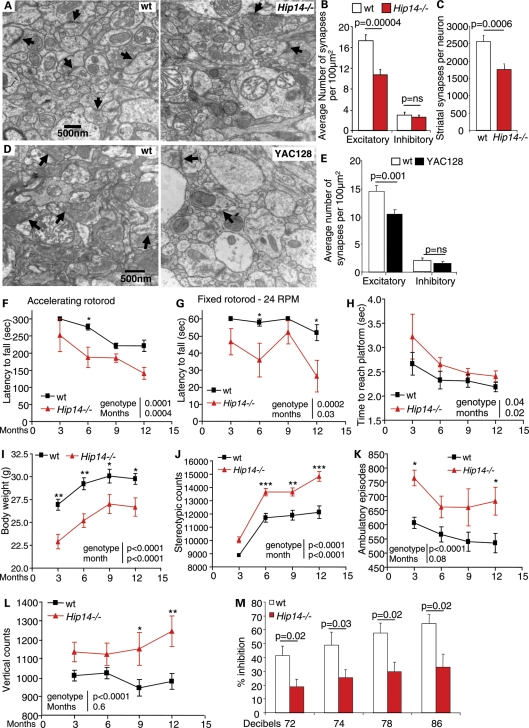Figure 3.
Loss of excitatory synapses and HD-like behavioral changes in Hip14−/− mice. (A) Representative fields of synapses from electron micrographs of striatum show decreases in the numbers of synapses (arrows) in 3-month-old Hip14−/− mice compared with the WT. (B) Quantification revealed a significant reduction in excitatory but not inhibitory synapses (n= 3 mice per genotype; 40 × 100 µm2 fields per genotype). (C) The number of excitatory synapses per neuron is significantly reduced in the Hip14−/− striatum. (D) Electron micrographs showing representative synapses in the striatum from 1-year-old YAC128 and WT mice. As in Hip14−/− mice, a decrease in the total number of synapses is observed. (E) A significant reduction in the number of excitatory synapses is observed in the striatum of YAC128 mice (n = 3 mice per genotype; 40 100 µm2 fields per genotype). All values are mean ± SEM. (F) Hip14−/− mice show a significant deficit on the accelerating and (G) fixed rotorod tests, indicating defects in motor co-ordination at 3, 6, 9 and 12 months of age (n = 7–10). In addition, Hip14−/− mice spend a longer time reaching a platform (H) indicating a decrease in swim speed and further implicating motor co-ordination deficits (n= 7–10). (I) Hip14−/− mice are significantly lower in body weight than controls at all ages tested (n= 15). (J–L) Hip14−/− mice are hyperactive as evidenced by increases in stereotypic, horizontal and vertical movements during open-field testing (n= 15–20). (M) Similar to HD patients and YAC128 mice, Hip14−/− mice show significant decreases in PPI compatible with dysfunction in the cortico-striatal pathway (n= 8).

